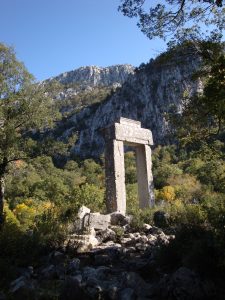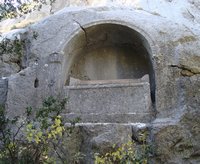The town that resisted Alexander
 In a country littered with ancient theatres, the one at the very top of Termessos is the most magnificent of all. Here you will feel as if you are sitting among the clouds, way up in the sky with only the birds to keep you company. The silence is magnificent, the scenery – an almost unbroken ring of mountains – out of this world. Never did the hurly-burly of modern life, the noise of traffic, the crush of people, the sheer ugliness of urban existence, seem so far away.
In a country littered with ancient theatres, the one at the very top of Termessos is the most magnificent of all. Here you will feel as if you are sitting among the clouds, way up in the sky with only the birds to keep you company. The silence is magnificent, the scenery – an almost unbroken ring of mountains – out of this world. Never did the hurly-burly of modern life, the noise of traffic, the crush of people, the sheer ugliness of urban existence, seem so far away.
Backstory
Termessos seems to have been founded around 1,000 BC by a group of people called the Psidians, who also settled Sagalassos, another spectacularly-sited city near Isparta in the Turkish Lake District. Not a great deal is known about the Psidians although they appear to have been a war-like bunch. The specific inhabitants of Termessos were also called the Solymi after Mt Solymus, the ancient name for what is now Güllük Dağı (Mt Güllük).
In his epic poem The Iliad Homer recounts how the king of Lycia set the hero Bellerophon a series of tasks, amongst which was flying over Solymus on the winged horse Pegasus and dropping stones onto the heads of its unruly inhabitants to force them into submission. The next time Solymus/Termessos crops up in the records is in 333 BC when Alexander the Great was working his victorious way across Asia Minor. Arriving beneath Termessos, Alexander apparently waited until nightfall to attack and defeat a small contingent of soldiers posted there but even he appears to have lost heart when faced with the natural defences of the site – a deep ravine between two cliffs – and so rode on to Sagalassos, leaving Termessos to glory in being one of only two places in Turkey (the other being Silyon, between Perge and Aspendos) that he was unable to capture.
From then on what little is known about Termessos is a series of battles with its neighbours, until eventually, like almost everywhere else, it was forced to accept Roman rule. Even then, however, the Termessians seem to have retained considerable autonomy and, as has often been pointed out, minted coins that did not show the head of the emperor.
But no matter how aggressively independent and naturally well protected they may have been, the Termessians were soon to vanish from the pages of history. In the early Christian period there seems to have been a bishopric on the site but by the fifth century silence had fallen on the mountainside. The usual earthquakes had done their best to bring down the splendid marble buildings but perhaps the site was just too cut off to survive for long once Attaleia (modern Antalya) got into its stride.
Around the site
You get to the ruins of Termessos from Antalya via the road to Korkuteli, where taxi drivers wait to pick up visitors.
It’s a short run up to the entrance to the Güllük Dağı National Park where cars can be parked beside the ticket office and a map indicates a circular route that takes you past all the main sights. The path up is good and well-maintained, and leads you through lovely old oak forest. To the right you will see a stretch of wall (now rebuilt) where it is thought that the Termessians supported themselves by collecting a toll from travellers heading between the coast and the interior of the country.
Eventually you will come to a line of sturdy buildings which served as a gymnasium and bath-house. Although earthquake damage is clear in the subsidence of some of the structures, many details still survive, including some delicate lion’s head decorations.
Squirrels run in and out of the stonework, jays flash back and forth amid the oaks, and purple crocuses push up from the soil. Already you know that this is somewhere very special, and already you will be wondering how it was ever possible to build in such a remote and lofty location.
The path keeps winding up past the scant remains of an agora (market-place), several temples and the so-called house of the founder. Then suddenly you emerge on a flat piece of land which is enclosed on one side by a wall that still stands to 10m high. You can’t get inside it because of the crush of rubble but archaeologists assume that it was either a bouleterion (meeting house) or an odeon, where small public performances might have taken place.
It’s easy to assume that you’ve reached the end of the trail until you realise that it actually carries on through the undergrowth and over yet more fallen rubble until eventually it emerges in that splendid theatre, more beautiful even than those at Bergama and Patara, and a great deal more romantic than those at Aspendos and Ephesus. (I have heard rumours of ‘restoration’ in the theatre but don’t know if it has actually happened.)
The theatre was built to accommodate the 4,200 town residents who came here to forget themselves in the words of the playwrights or to glory in the no doubt gory wild animal spectacles that were laid on to amuse them. It was a relatively late addition to the site, dating back only to the Hellenistic era (after the fourth century BC).
 Without sturdy shoes, it’s wise to return the same way that you came up, since the path down through the old necropolis is both less clear (look out for white dots on the rocks as guidance) and much rougher. But the back route down certainly repays the effort if only by passing the remains of an ancient quarry, thereby answering the “how did they get the stones up here” question.
Without sturdy shoes, it’s wise to return the same way that you came up, since the path down through the old necropolis is both less clear (look out for white dots on the rocks as guidance) and much rougher. But the back route down certainly repays the effort if only by passing the remains of an ancient quarry, thereby answering the “how did they get the stones up here” question.You will also bypass the graves of what must have been the most illustrious Termessians, some of them free-standing stone sarcophagi of the sort to be seen around Kekova, others of them rock-cut rather like the tombs of Myra and Dalyan.
By the time you re-emerge at the car park you will be in little doubt as to why even Alexander the Great thought better of taking on the city.
Sleeping
Antalya makes the best base for a visit to Termessos. The nicest places to stay are in Kaleiçi, the area immediately beside the harbour.
Transport info
There are hourly buses from Antalya otogar to Korkuteli where taxis wait to save you the nine-km uphill trek to the site.


